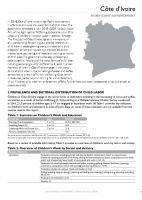The U.S. Department of Labor’s annual report on the Findings on the Worst Forms of Child Labor assesses progress made in the global fight against child labor. The 2018 report includes country specific summaries for Ghana and Côte d’Ivoire, among others.
Summary of the main findings and recommendations for Ghana:
- Ghana made a “moderate advancement” in 2018 to eliminate the worst forms of child labour.
- According to ILO analysis of the Ghana Living Standard Survey, round 6 (2012-3), an estimated 24.7% of children work (1,721,914) across the country. Of them, 78.7% work in agriculture, including the production of cocoa, palm oil, coffee, herding livestock and fishing.
- Noted efforts include the approval of the National Plan of Action Phase II on the Elimination of the Worst Forms of Child Labour; convictions for offences related to the worst forms of child labour; and coordinated efforts to address cross-border trafficking.
- Gaps remain in Ghana’s legal framework (use of children in commercial sexual exploitation, protection for domestic workers); law enforcement (authority of the Ministry of Employment and Labour Relations, personnel, training, financial and material resource allocation; inter-agency coordination); policies (mainstreaming chid labour issues in other policies); social programmes (scope, funding).
- Recommended actions for government to advance the elimination of child labour include: increasing the recruitment and training of labour inspectors; establishing a mechanism to track cases of child labour for referral to law enforcement or social service providers; integrating child labour elimination and prevention strategies into existing policies.
- Read the full report for Ghana
Summary of the main findings and recommendations for Côte d’Ivoire
- Côte d’Ivoire made a “significant advancement” in 2018 to eliminate the worst forms of child labour.
- According to ILO analysis of statistics from the Enquête Démographique et de Santé (2011–2012), an estimated 31.5% of children work (1,682,754) across the country. According to Unicef, 21.5% of children aged 5–17 are engaged in hazardous work. These figures include children working in cocoa-production, other forms of agriculture, industry and services.
- Noted efforts include the development of the 2018-20 National Action Plan of the Fight Against Trafficking, Exploitation and Child Labour; the drafting of a National Labour Inspection Strategy; the First Lady’s support to applied research on child labour in cocoa-growing areas; and the opening of a child protection centre for “victims of child labour”.
- Gaps remain in law enforcement (training for investigators on existing laws and identification of victims, personnel, and financial resource allocation); coordination (particularly data collection on child labour among ministries and across different regions), policies (funding and mainstreaming child labour issues into relevant policies); and social programmes (scope, resource allocation, and reliance on NGOs for service delivery to victims of child labour and trafficking).
- Recommended actions for government to advance the elimination of child labour include: ensuring coordinating bodies function as intended; improving coordination on data collection among ministries and between different regions; integrating child labour elimination and prevention into all relevant strategies; eliminating school-related fees; improving school accessibility; ensuring schools are free of physical and sexual abuse; increasing the number of schools, teachers and sanitation facilities, especially in rural areas; expanding social programmes to address the scope of the child labour problem; ensuring they are implemented in accordance with their mandate.
